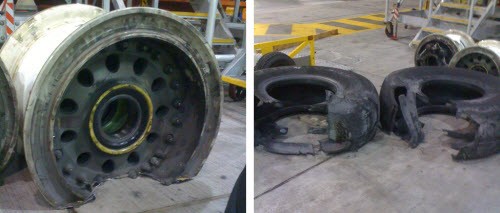Photos of the damage done to a Qantas A380 at Sydney Airport on March 31 have fallen off a passing Sopwith Camel. They show what happens to the world’s largest passenger jet when the anti-skid braking system attached to the front two wheels works with maximum efficiency — when not intended.



Basically, they bring wheel rotation to a complete standstill: the inner wheel glows red hot, the “fusible” plugs in the tyre sidewall melt and flames shoot out — all in a split second because hundreds of tonnes of the rest of jet is pushing them down the runway. This also relieves the tedium of just another landing for anyone watching it on the seat-back video screen through the tail-mounted camera.
Many of the 244 passengers on board at that moment saw flames and sparks shoot out from under the jet and heard a loud explosion quite out of keeping with the serenely silent ambience of an A380. “Fusible” plugs work their magic many times a year on modern jets when, for any reason, an undercarriage overheats.
A recent example occurred at Hong Kong on Tuesday when a Cathay Pacific A330 was about to land and its two Rolls-Royce engines failed to proceed in the manner expected of the marque. The plane hit the runway rather firmly and ground to a halt with multiple shredded tyres, injuring eight passengers.
By letting a jet tyre deflate predictably, fusible plugs also give pilots more certainty about how a jet will respond when the brakes need to be used in anger. Sometimes they also prevent the actual wheel being destroyed in the process but in this case they suffered obvious damage.








I was on the flight in question. It wasn’t the tyres on the front two wheels (i.e. the nose wheels) that deflated, it was those on the front two wheels on the left underwing set (as the top photo shows fairly clearly).
Yup. My eyeballs locked up after reading ‘front two wheels’ and not reading on.
Blush!
Damn it, Sandilands, I am flying soon. You needed a bigger gap between the heading and the pictures.